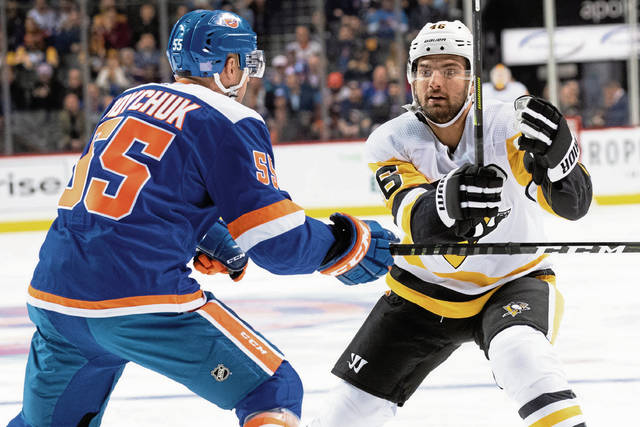https://triblive.com/sports/5-on-3-penalty-kills-unique-challenge-for-penguins/
5-on-3 penalty kills unique challenge for Penguins

NEWARK, N.J. — The Pittsburgh Penguins fell behind by two goals to the visiting Chicago Blackhawks on Nov. 9.
It has been a problem lately for the Penguins, who have not claimed the first lead of a game since Oct. 29, when they blasted the Philadelphia Flyers, 7-1. That includes Friday night’s game against the New Jersey Devils.
Against Chicago, the Penguins rallied for a 3-2 victory in a shootout.
That deficit might have been even more daunting if not for a nerve-racking sequence that lasted 1 minute, 34 seconds during the second period.
The Blackhawks were gifted a five-on-three power play after defenseman Jack Johnson took a tripping minor and Brandon Tanev was assessed a boarding penalty 26 seconds later.
With two of his top penalty-killers in the penalty box, coach Mike Sullivan called timeout, mostly to give his players a breather but also to make adjustments.
“That was a tough one because we had lost (forward Bryan Rust) for a period of time on the bench with an equipment issue,” Sullivan said. “We only have a certain amount of five-on-three (penalty killers) that we think are really good at it. When we lost him, it’s just one more guy that we (didn’t) have the opportunity to put on the ice. That was the reason we called the timeout.
“That’s not something that I love to do, but I thought in that circumstance, given the fact that we had lost (Rust) off the bench, it was in our best interest because it would give our three best (available) penalty-killers an opportunity to recover a little bit to try to get through that.”
After that stoppage, Sullivan deployed forwards Zach Aston-Reese, Teddy Blueger and defenseman Brian Dumoulin to turn away Chicago’s power play, which is blessed with All-Stars such as Patrick Kane and Duncan Keith.
But all the Blackhawks could do was put two shots on net.
“They are more of a team that tries to pass it to the net rather than shoot it,” Aston-Reese said. “We knew that they were going to try to move it around rather than try a backdoor play. They had one close chance, but it was a really hard pass from (Kane). I think it was (forward Alex) DeBrincat backdoor or something, but he wasn’t able to handle it. But we just did a really good job of staying in shooting lanes from the top.”
Any momentum the Penguins hoped to garner quickly was extinguished when Blackhawks forward Dominik Kubalik scored a five-on-five goal 1:04 after Tanev’s minor had expired. But the Penguins felt that penalty kill put them in a position to claim a victory.
“It’s exciting, for sure,” Aston-Reese. “I think you look at the games where teams get their five-on-three kills, and they kill it off. That team usually goes on to win. Or after that, you just rally.”
What’s the biggest difference in killing penalties with only three players? It might be how the the opposing power play attacks. It tends to be far more selective with shooting the puck.
“When you’re on a five-on-three (as the attacking team), you try to look for clean looks, where with a five-on-four, you just shoot from the top and look for tips and rebounds,” Blueger said. “With a five-on-three, you’re not doing that. We kind of knew a little bit of what they were trying to do. I thought we did a good job of staying tight, trying to take away the lanes and stuff. When we did get beat, (Matt) Murray made a couple of big saves.”
In a sport that demands so much sacrifice to players’ well being, that notion might be most evident during a five-on-three penalty kill.
“Before going into it, it’s a little self-talk that you’re going to have to put your body on the line at some point,” Aston-Reese said. “You’re going to have to. You’re going to eat a slap shot or a hard shot. You get over that quick. It’s just about you got to be smart. Have a good rotation. It’s more tactical once you get past that fear of taking a shot in the face potentially.”
Five-on-three chances are rare. Before Friday’s games, there had been 1,820 five-on-four power-play opportunities this season and 61 chances at five-on-three. Five teams have yet to have a five-on-three this season.
When they do happen, it requires a different approach.
“I don’t know if I’d say pressure,” Blueger said. “But it seems like when you’re defending five-on-four, you can maybe get away with a mistake, whereas a five-on-three, you’ll probably get exposed more.”
“You’re probably going to give up some decent chances,” Johnson said. “Honestly, a situation like that, your goaltender has to be your best killer. You’re trying to play the percentages. You figure out who they’re trying to get the puck to. You have a decent idea before it starts. You try to deny them that one option and have them beat you some other way. That’s really all you can do. You’re outnumbered pretty badly in that situation.”
Notes: Neither team had a morning skate. … Goaltender Mackenzie Blackwood is expected to start for New Jersey. In 12 games this season, he has a 5-4-3 record along with a 2.94 goals-against average, an .895 save percentage and one shutout.
Follow the Penguins all season long.
Copyright ©2025— Trib Total Media, LLC (TribLIVE.com)
